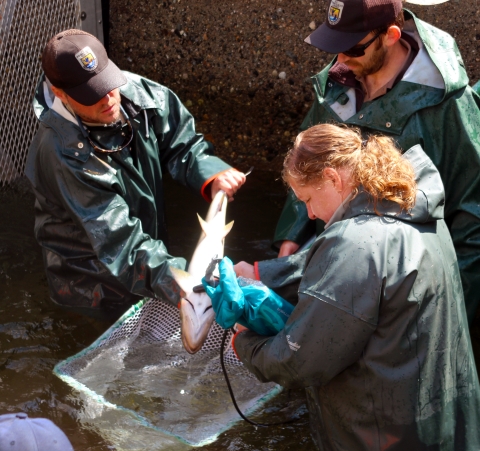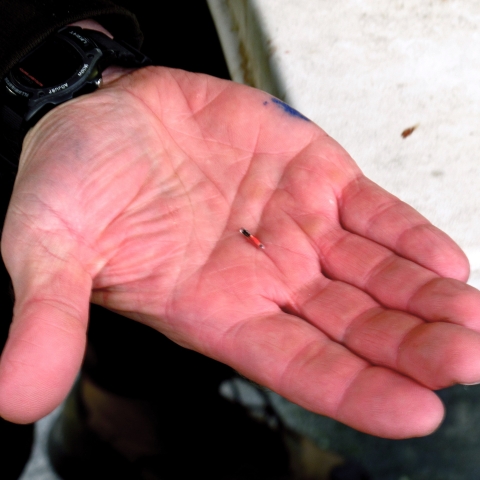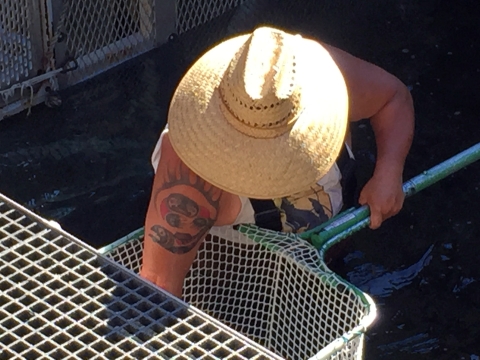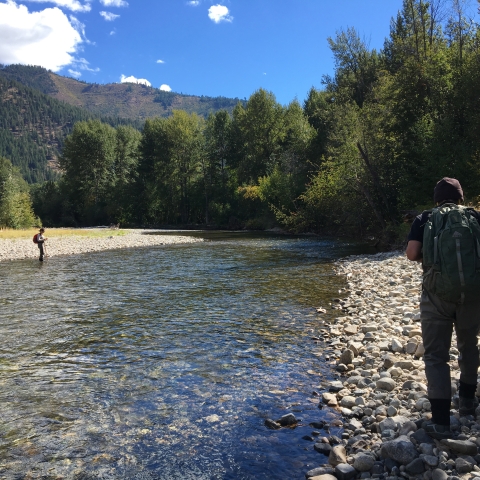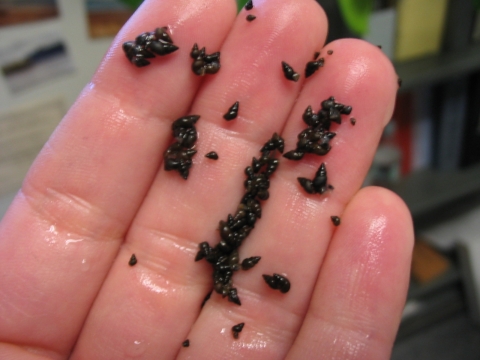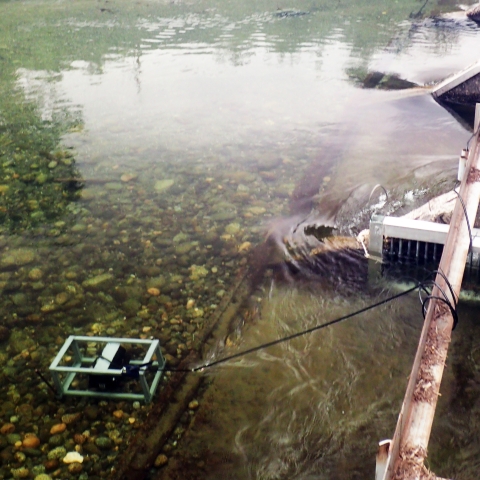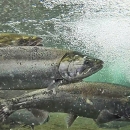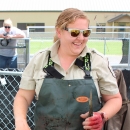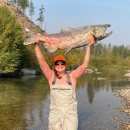We look for ways to optimize the performance and contribution of the fish we raise in our hatcheries.
Mission Statement
The Mid-Columbia Fish & Wildlife Conservation Office's Hatchery Evaluation (HE) program uses monitoring, evaluation, and targeted research to assist the Leavenworth Hatchery Complex in effectively meeting both its mitigation goals and ESA responsibilities. The HE program assists in guiding the Complex in making decisions that balance the benefits of artificial production against the risks to the natural environment.
Program Objectives
Currently, the objectives of the HE program are to:
- Research, develop, and implement methods to assess and optimize program performance while minimizing the impacts of hatchery production on natural fish populations and the environment.
- Facilitate coordination with the various managers involved in artificial production, evaluation, and management of fisheries within the Columbia River basin.
These objectives are outlined and supported in the Complex's governing documents, including each facility’s Hatchery Genetics Management Plan (HGMP), Washington State Department of Ecology permits, and Biological Opinions (BiOps) from NOAA Fisheries and the USFWS.
Performance Optimization
The HE program’s objective of performance optimization requires collection and analysis of data based on fish from all three Complex hatcheries. HE biologists analyze and monitor juvenile outmigration performance, evaluate survival at multiple stages, predict adult returns, provide science-based recommendations to fisheries managers, minimize straying, optimize brood use, and evaluate population metrics. In addition, the HE program conducts targeted research studies to address key uncertainties. All research, monitoring, and evaluation are conducted with the goal of optimizing program performance while minimizing risk.
Risk Minimization
The HE program evaluates the impacts of artificial fish production on natural-origin fish populations and their environments using data we collect at the Complex’s hatcheries, spawning ground surveys and data collected by others throughout the Columbia River basin. The Complex's governing documents require evaluation of these hatchery production impacts. They are broadly broken into two areas of concern: 1) effects of the interactions of the hatchery-origin fish on natural-origin fish populations, and 2) effects of hatchery operations and infrastructure on the environment.
Collaborative Effort
The HE program coordinates studies, findings, and/or changes in Complex operations with stakeholders and regulating agencies, and actively represents USFWS interests by serving on a variety of committees. Understanding and coordinating the needs of co-managers and stakeholders aids in avoiding duplicative efforts and directs resources towards Complex responsibilities and broader USFWS goals.
Our Projects
Marking and Tagging
The HE program designs and implements marking and tagging programs at all Leavenworth Complex hatcheries. This includes ensuring that all hatchery-origin are adipose clipped so they are distinguishable from natural-origin fish when captured, allowing them to be retained in mark select fisheries. Additionally, we implant a portion of all fish released with tags (PIT and coded-wire) so we can assess their migration, survival, and contribution to assist fisheries management decisions.
Juvenile Release Monitoring
Each year, thousands of juvenile salmon leave Complex hatcheries with coded-wire tags and some with PIT tags. Coded-wire tags are small pieces of wire implanted in the head of the fish. Each wire contains a six digit code that identifies the hatchery the fish came from. Coded-wire tags can be detected within the fish but not read without being collected. HE staff spend time during the winter dissecting these small metal tags from the frozen snouts of fish that returned to the hatchery or were found during spawning ground surveys. Tag information data is collected by many entities along the west coast, from California to Alaska; and is critical to determine where our fish contributed to harvest fisheries, where they strayed, how many spawned naturally, and to determine the origin of adults used for broodstock broodstock
The reproductively mature adults in a population that breed (or spawn) and produce more individuals (offspring or progeny).
Learn more about broodstock at Complex hatcheries. PIT (passive integrated transponder) tags are very similar to the radio frequency identification (RFID) tags that a veterinarian would implant in your dog or cat. PIT tags help HE biologists track salmon as they leave the hatchery and travel down the Columbia River and back. Unlike coded-wire tags PIT tags can be read without removing them from the fish, so live fish continue to provide biologists with data through the course of a fish's life. As fish move through rivers and streams on their way downstream as juveniles and upstream as adults, they pass numerous sites such as dams that contain antennas that read the PIT tags. These detections inform HE biologists where the fish are, how fast they are moving and how many have survived.
Run Forecasting
HE biologists develop run forecasts to predict the number of adults anticipated to return from the ocean each year. Run forecasts assist fisheries harvest managers in efficiently regulating fisheries and (to the extent possible) maximizing harvest opportunities. Additionally, spawning run forecasts inform hatchery managers about the size of the run so they can work with harvest managers to meet their broodstock needs and provide surplus fish (when available) to upper Columbia River tribes.
Hatchery Sampling
Every year, HE biologists sample thousands of salmon and steelhead that return to Complex hatcheries . They collect data on their size, gender, and origin to assess the characteristics of the population. This information is vital for optimizing the performance of each program, as these adults are the final product and the future of subsequent generations.
Spawning Ground Surveys
Each fall, HE biologist and technicians head out onto local streams and rivers to collect data on spawning salmon. They document the distribution and abundance of salmon redds to determine the size of the spawning population and monitor how it changes over time across the river. HE biologists use spawning ground survey data to evaluate redd superimposition of potential hatchery-origin salmon redds on natural-origin salmon redds. Hatchery operation permits determine the level of redd superimposition that may be attributed to a specific hatchery. HE biologists also collect data from carcasses found on the spawning grounds to determine the origin (hatchery or natural by tag or scale analysis), age and sex composition of the spawning population. These data provide HE staff with information to determine the impact of hatchery fish on the natural populations which is critical to assess the recovery of these species. In the Methow Sub-basin, these efforts are coordinated with the Washington Department of Fish & Wildlife and the Yakama Nation.
Aquatic Nuisance Monitoring
Late each summer and early fall, HE biologists sample the river above, below, and at each Complex hatchery looking for aquatic nuisance species (ANS) such as New Zealand mudsnails. Specimens collected from ANS samples is sent off to a lab for screening. To date, no ANS have been detected; but it is hoped that through early detection, the spread of these troublesome organisms could be minimized.
Icicle Creek Passage Monitoring
From mid-May through June, HE biologists monitor fish passage fish passage
Fish passage is the ability of fish or other aquatic species to move freely throughout their life to find food, reproduce, and complete their natural migration cycles. Millions of barriers to fish passage across the country are fragmenting habitat and leading to species declines. The U.S. Fish and Wildlife Service's National Fish Passage Program is working to reconnect watersheds to benefit both wildlife and people.
Learn more about fish passage past Leavenworth NFH both day and night seven days a week. How do we do this? By using underwater dual identification sonar (DIDSON video). Much like how a bat sees in the dark by using acoustics to avoid obstacles or catch prey, the DIDSON uses sound to create the shape of fish as they pass. HE biologists count and measure the number of fish that pass both up and downstream of the hatchery.
